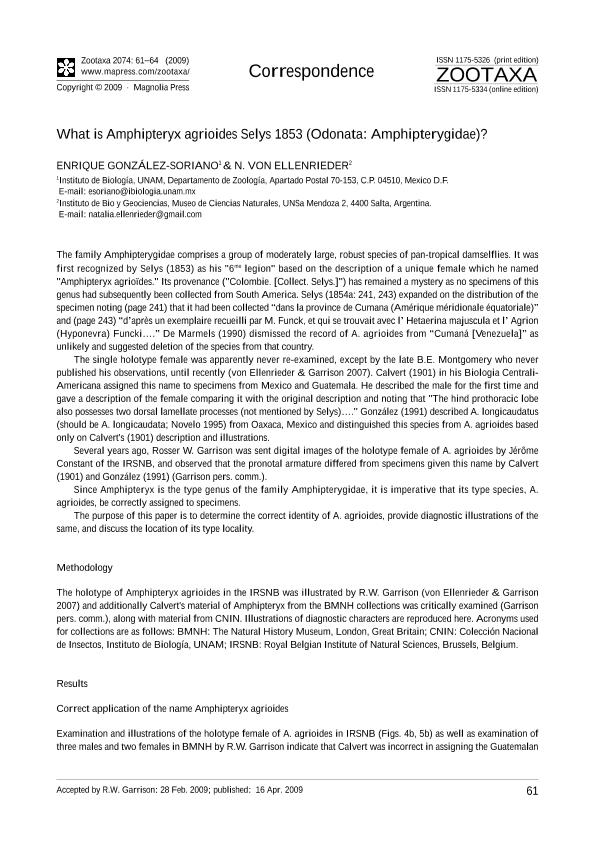Mostrar el registro sencillo del ítem
dc.contributor.author
González Soriano, Enrique
dc.contributor.author
Von Ellenrieder, Natalia

dc.date.available
2018-08-06T17:15:55Z
dc.date.issued
2009-04-16
dc.identifier.citation
González Soriano, Enrique; Von Ellenrieder, Natalia; What is Amphipteryx agrioides Selys 1853 (Odonata: Amphipterygidae)?; Magnolia Press; Zootaxa; 2074; 16-4-2009; 61-64
dc.identifier.issn
1175-5326
dc.identifier.uri
http://hdl.handle.net/11336/54263
dc.description.abstract
The family Amphipterygidae comprises a group of moderately large, robust species of pan-tropical damselflies. It was first recognized by Selys (1853) as his "6me legion" based on the description of a unique female which he named "Amphipteryx agrioïdes." Its provenance ("Colombie. [Collect. Selys.]") has remained a mystery as no specimens of this genus had subsequently been collected from South America. Selys (1854a: 241, 243) expanded on the distribution of the specimen noting (page 241) that it had been collected “dans la province de Cumana (Amérique méridionale équatoriale)” and (page 243) “d’après un exemplaire recueilli par M. Funck, et qui se trouvait avec l’ Hetaerina majuscula et l’ Agrion (Hyponevra) Funcki….” De Marmels (1990) dismissed the record of A. agrioides from “Cumaná [Venezuela]” as unlikely and suggested deletion of the species from that country. The single holotype female was apparently never re-examined, except by the late B.E. Montgomery who never published his observations, until recently (von Ellenrieder & Garrison 2007). Calvert (1901) in his Biologia CentraliAmericana assigned this name to specimens from Mexico and Guatemala. He described the male for the first time and gave a description of the female comparing it with the original description and noting that "The hind prothoracic lobe also possesses two dorsal lamellate processes (not mentioned by Selys)…." González (1991) described A. longicaudatus (should be A. longicaudata; Novelo 1995) from Oaxaca, Mexico and distinguished this species from A. agrioides based only on Calvert's (1901) description and illustrations. Several years ago, Rosser W. Garrison was sent digital images of the holotype female of A. agrioides by Jérôme Constant of the IRSNB, and observed that the pronotal armature differed from specimens given this name by Calvert (1901) and González (1991) (Garrison pers. comm.). Since Amphipteryx is the type genus of the family Amphipterygidae, it is imperative that its type species, A. agrioides, be correctly assigned to specimens. The purpose of this paper is to determine the correct identity of A. agrioides, provide diagnostic illustrations of the same, and discuss the location of its type locality.
dc.format
application/pdf
dc.language.iso
eng
dc.publisher
Magnolia Press

dc.rights
info:eu-repo/semantics/openAccess
dc.rights.uri
https://creativecommons.org/licenses/by-nc-sa/2.5/ar/
dc.subject.classification
Otras Ciencias Biológicas

dc.subject.classification
Ciencias Biológicas

dc.subject.classification
CIENCIAS NATURALES Y EXACTAS

dc.title
What is Amphipteryx agrioides Selys 1853 (Odonata: Amphipterygidae)?
dc.type
info:eu-repo/semantics/article
dc.type
info:ar-repo/semantics/artículo
dc.type
info:eu-repo/semantics/publishedVersion
dc.date.updated
2018-07-23T17:07:58Z
dc.identifier.eissn
1175-5334
dc.journal.volume
2074
dc.journal.pagination
61-64
dc.journal.pais
Nueva Zelanda

dc.journal.ciudad
Auckland
dc.description.fil
Fil: González Soriano, Enrique. Universidad Nacional Autónoma de México. Departamento de Botánica. Instituto de Biología; México
dc.description.fil
Fil: Von Ellenrieder, Natalia. Consejo Nacional de Investigaciones Científicas y Técnicas. Centro Científico Tecnológico Conicet - Salta. Instituto de Bio y Geociencias del NOA. Universidad Nacional de Salta. Facultad de Ciencias Naturales. Museo de Ciencias Naturales. Instituto de Bio y Geociencias del NOA; Argentina
dc.journal.title
Zootaxa

Archivos asociados
